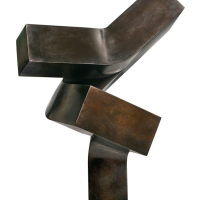73. CLEMENT MEADMORE

There is a cool uniformity to the sculptures of Clement Meadmore. They are as comfortably seen outdoors as they are within. Neither landscape nor interior seem to affect their appearance because they come to us readily formed. Our initial response is one of autonomy but as we move and take account of the sculptures mass, our perception changes.
Clement Meadmore came to prominence in Australia in the late 1950s, but by 1963 he had settled in New York. Meadmore entered a milieu that was exciting and accommodating. He visited studios and saw paintings by Mark Rothko (1903-1970) and Barnett Newman (1905-1970) and the sculpture of Donald Judd (1928-1994). He was immediately impressed by new and abstract forms, and it was this impulse that gave impetus to Meadmores sculpture.
Meadmore quickly modified his forms in two ways: he abandoned texture and took his sculpture from the plinth to the floor. Sculptures became steel cubes, industrial in look. Each change encouraged Meadmore in a move to pure abstraction. Early images show multi-block sculptures, some in combination, on or slightly above the ground. The activation of the floor becomes critical to Meadmore as it did to sculpture of this period. Clement Greenberg the critic and theorist of new abstraction noted:
It is its physical independence, above all, that contributes to the new sculptures status as the representative visual art of modernism. A work of sculpture, unlike a building, does not have to carry more than its own weight, nor does it have to be on something else, like a picture; it exists for and by itself literally as well as conceptually. And in this self-sufficiency of sculpture, wherein every conceivable as well as perceptible element belongs together to the work of art, the positivist aspect of the modernist aesthetic finds itself most fully realized.1
The many iterations of a Meadmore sculpture introduce our current lot Always 1991. Once coined, the title of a Meadmore sculpture evokes associations. The word always implies repetition, a return to habit, but Meadmores title is left dangling because as we enter the visual domain the meaning changes. Always has many faces. It stands upright, the lower section a solid base from which the shape seesaws diagonally and upwards.
The same applies to the larger version Always 1992 (Johnson County Community College Collection, Kansas). It is a sculpture of at least six metres. Being under this great weight alters dramatically what is felt in Always 1991. The former is experiential to a greater degree and the latter more so domestic and assimilable to enclosed architecture.
The notion of indoor/outdoor is fundamentally coexistent and a dialogue about the placement of Meadmores sculpture is with us in thought. Always 1991 is bronze and richly patinated. Its form is cross-like, and the geometry a nexus that unfolds in space. Words describe forms: a gate, a door, a window. In sculpture, words describe surfaces; they are necessary, but the interpretation of Always remains elusive and intriguing. It is an image first, which in parallel to the singular integrity of the sculpture makes Always recondite and desirable.
Footnotes:
1. Greenberg, C., The New Sculpture, in Art and Culture: Critical Essays, Beacon Press, Boston, 1989, p.145
Brett Ballard